The 2021 NHL Draft is shaping up to be one of the most confusing and chaotic drafts in the last 50 years. Several factors have converged, creating a figurative perfect storm: coronavirus outbreaks have limited schedules in several leagues around the world and forced tournaments to cancel their events, the expansion draft for the Seattle Kraken is set to take place days before, the draft class is arguably a weaker group, the OHL has yet to start their 2020-21 season, and the WHL has only been playing for a week. With so much uncertainty, NHL clubs were pushing to delay the draft until 2022, although the league has stated that won’t happen at this time.
All of that has created an incredibly difficult task for pro scouts, and as a result, no one can agree on who should be first overall. It’s the first time there hasn’t been a consensus first-overall selection in several years, and possibly the first time ever that at least six players have all seen their names at the top of one list or another. For the casual observer, it can be very hard to keep track of who’s the current favourite, especially when it’s changed several times over the past month and could very well change in the coming months.

It’s definitely how I’ve felt in the last few weeks as I dive into writing prospect reports for some of the top prospects available in 2021. Draft rankings have been far more volatile than ever before, with many players having a range of 10 to 15 possible spots where they could be selected. So, in an effort to simplify everything, I’ve gone through some of the best and most popular rankings publicly available and created a consolidated top-10 list of who currently is a first-overall candidate. This isn’t a ranking; Matthew Zator, Peter Baracchini, and Andrew Forbes have that side taken care of for The Hockey Writers. Instead, this is a breakdown of the top prospects’ skills, weaknesses, and chances of ending up the first pick in 2021.
Matthew Beniers
Why he could be first: In a season where different leagues have been wildly inconsistent, Beniers’ performance at the 2021 World Juniors could be the deciding factor for many scouts. He had a solid season with the U.S. National U18 team, posting 18 goals and 41 points in 44 games and another 16 points in 16 games with the United States National Development Team, but he wasn’t considered more than a mid-first round pick. That is, not until the World Juniors, where he emerged as a key contributor on the American team when other notable players were unavailable. Despite being the youngest on the roster, he was regularly on the second line and scored a goal and three points en route to the gold medal.
Seeing his ability to do it all on display against the world’s best prospects has done wonders for his draft rankings, and he has jumped up to first for all three of The Hockey Writers’ scouts. He’s continued his dominance as a freshman with the University of Michigan, leading his team with 10 goals and sitting third with 23 points. Combined with a very projectable 6-foot-1 frame, he seems to be on track to be a top-line two-way center.
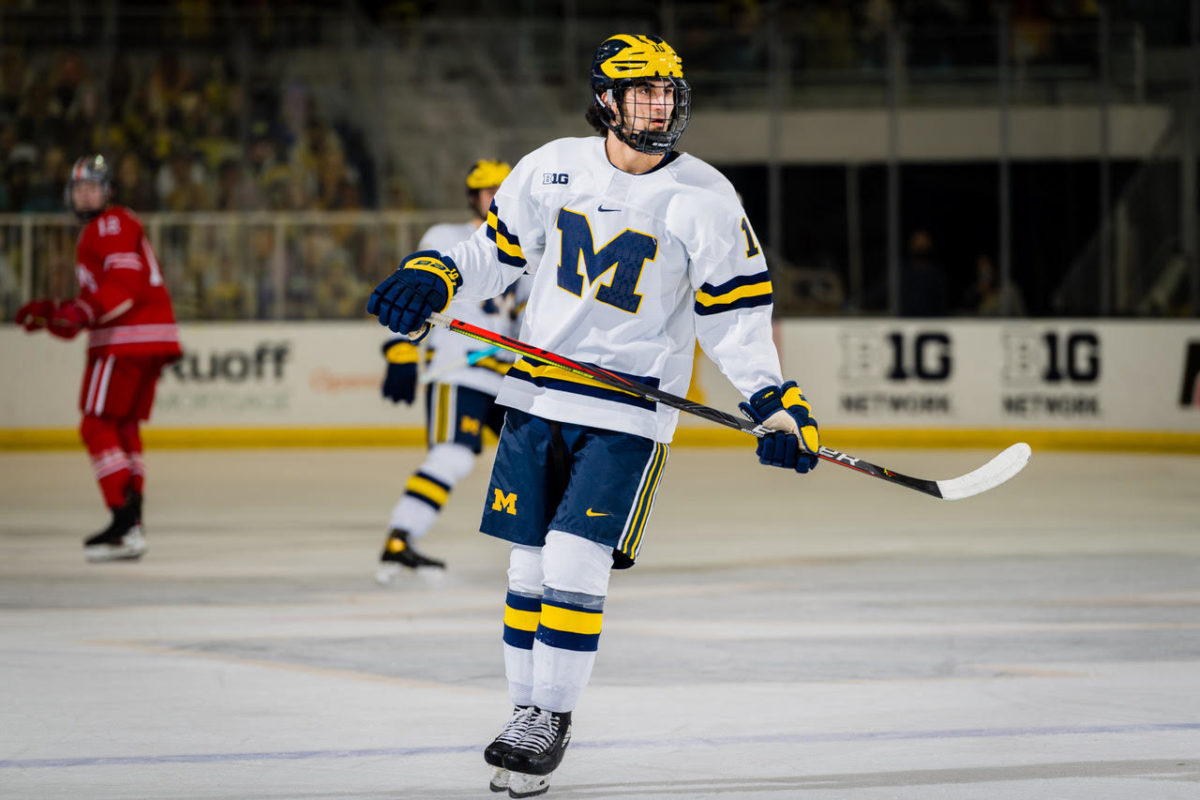
Why he might fall: Scouts have been hard-pressed to find an ability or skill that Beniers’ isn’t outmatched in by another 2021 prospect. He plays a smart, mature, defensively-aware game and is this year’s physical embodiment of the saying, “A jack-of-all-trades is a master of none, but oftentimes better than a master of one.” The only problem is some scouts may not agree. His offensive upside isn’t as high as some others on this list, and though he could develop into a top center like Mathew Barzal, he could just as easily be a grinding second or third-line player. He’ll make the NHL; of that, there’s almost no debate. But as to his full potential, scouts right now are divided.
Luke Hughes
Why he could be first: The NHL is seeing a rise in offensive-minded, highly mobile defensemen like Cale Makar and Quinn Hughes, which is exactly what style of game Luke Hughes plays. He’s been one of the hottest risers in the 2021 Draft lately and was ranked first by FC Hockey, thanks to an incredible start with the U.S. National U18 team this season. The fluid-skating defenseman has been almost unstoppable as an offense driver, posting six goals and 32 points in as many games, and ranks fourth in team scoring. He’s also had a huge season in the USHL, scoring 13 points in 13 games, which is a massive increase from last season, where he finished with 13 points in 29 games. It’s a similar pace to his older brother Quinn, which is a great sign of things to come.
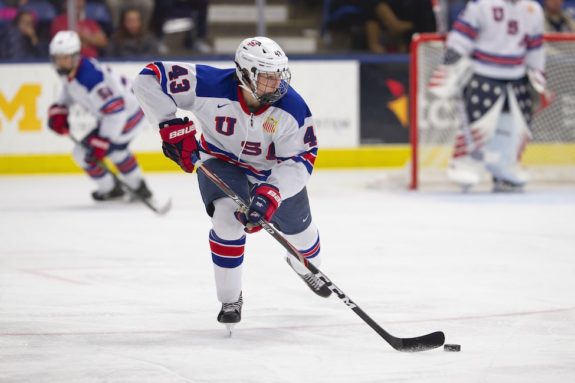
Why he could fall: Hughes is one of the youngest players eligible at the draft — just a few days shy of being eligible for the 2022 Draft — and as a result, his game is still very raw. It also hasn’t helped that he’s taken the same path as Quinn and Jack, both of whom looked more polished than Luke at the same age. He also doesn’t have the strongest nor the most accurate shot, and when compared to other offensive defensemen available at the top end of the 2021 Draft, he has one of the lower shots-on-goal percentages from low-danger areas high in the slot. He may be the biggest Hughes brother at 6-foot-2, but he still is not an overly big player, and he’ll need to add some muscle and strength before he makes an impact in the NHL.
Owen Power
Why he could be first: There are not many players who come along who are both big and highly skilled, yet Power is the perfect blend. The Michigan defender is 6-foot-6, 214 pounds, and when he gets up to speed, he’s nearly unstoppable. He can move like few others his size, which is an attribute that makes him very attractive to many NHL teams. His potential is sky-high at the moment, and there’s a chance he could become a Chris Pronger-type of franchise defenseman for a team. Even if his skill set is a bit raw, that’s a risk most teams would take if given the chance, and TSN’s Bob McKenzie picked him to go first back in December.
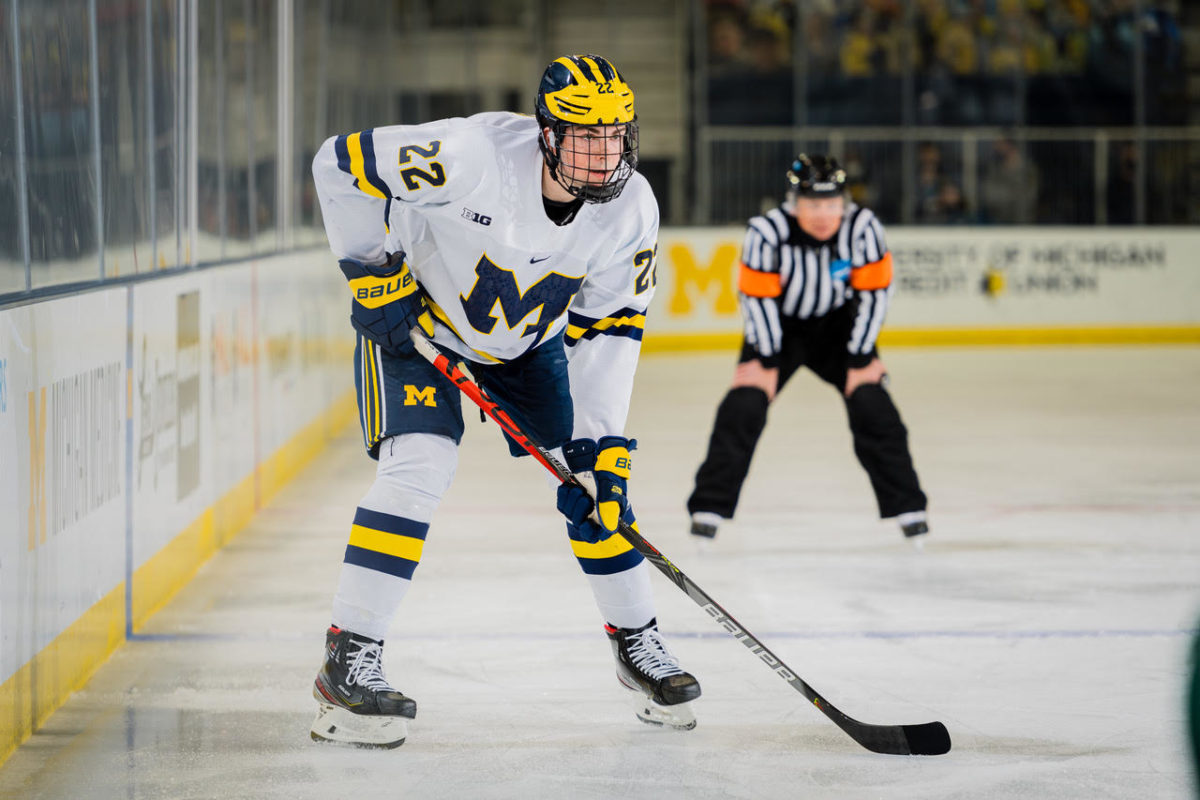
Why he might fall: There are too many players who have been drafted completely based on their size, and in almost every case, the player never made it in the NHL. 6-foot-4 Griffin Reinhart went fourth in 2012 but played 37 NHL games; 6-foot-5 Erik Gudbranson went third overall in 2010 and has failed to stay on a team longer than four seasons; 6-foot-5 Jared Cowen went ninth in 2009 and has 45 points to his name after six seasons. And while there are still some old-school hockey guys who love to have big players on their team, the league is transitioning to a faster, offense-driven style, which leaves a lot of big guys behind, no matter how good their skating is.
Also like Pronger, Power has a tendency to play on the edge of disaster, according to Tony Ferrari of Dobber Prospects. His defensive awareness and hockey IQ can be concerning sometimes, and he runs the risk of making a fatal error on a play. Altogether, it makes Power a risky pick at the top end of the draft. He could end up being the best player from his class, but he could just as likely be a bust.
William Eklund
Why he could be first: William Eklund may be the most skilled prospect at this moment. Not only is the 18-year-old currently playing in the Swedish Hockey League against former NHL players, but he’s also doing so in a top-six role, an incredibly rare feat for a teenager in the world’s third-best league. His 11 goals and 20 points with Djurgårdens IF leads all under-19 players in the SHL, including 2020 draft picks Alexander Holtz and Lucas Raymond.
Although he has slowed down recently, Eklund was on pace to finish his draft-eligible season in the same ballpark as Daniel Sedin, Henrik Sedin, and Peter Forsberg. He’s even drawn some comparisons to Sidney Crosby for his incredibly high hockey IQ and willingness to grind it out in the corners. Even if his ceiling isn’t as high, that’s some incredible company to be with and prompted Dobber Prospect’s Cam Robinson and Eliteprospects to make him his pick for first.
Why he could fall: Just like how Power will get extra attention because of his frame, Eklund will lose some simply due to the fact that he stands 5-foot-10. The NHL still sees size first, despite the growing number of sub-six-foot All-Stars, and many are still underrated in today’s game. Marco Rossi was a top-five talent until draft day when he fell to ninth, likely due to his diminutive 5-foot-9 stature. He’s also not the fastest skater, which has become a major skill that scouts look for.
However, what may end up being a deciding factor is that Eklund missed the 2021 World Juniors due to a positive COVID test. Not being able to see him compete against the other top prospects from around the world may place him slightly lower than other prospects like Beniers, who were able to show their skills against the world’s best.
Fabian Lysell
Why he could be first: Talk about dynamic players. Fabian Lysell is an incredibly gifted winger who could have the most intense pace in his draft class. He approaches each game as though the title is on the line, using his blazing speed, great stickhandling, and aggressive attack to overcome the defense and create scoring chances. Everything is done at full throttle, and at both the U18 and U20 levels, he’s been virtually unstoppable. In 2019-20, with the Frolunda HC J18s, he had 34 points in 13 games. This season, he made his SHL debut after putting up 13 points in 11 games with the J20s. He’s currently Dobber Prospects’ Tony Ferrari’s favourite to go first overall in July.
Why he could fall: Like Eklund, Lysell’s size could hold him back from being the first overall pick. At 5-foot-10, he will be seen as undersized for the NHL, and his aggressive approach has at times gotten him into situations where he has been at a significant size disadvantage. His SHL stats have also been underwhelming — in 25 games, he has just three points — which is made slightly worse by the fact that he requested a trade from Frolunda in order to play in Sweden’s top league. That’s caused some to question his maturity and hockey IQ, and as a result, he’s been ranked anywhere from first to 14th.
Brandt Clarke
Why he could be first: Brandt Clarke is an offensively-minded defender and could have the highest ceiling at the 2021 Draft. Last season as a rookie with the OHL’s Barrie Colts, he had 38 points in 57 games, displaying an ability to crash the net not often seen among defensemen. This season, he decided to go and play professional hockey in Slovakia, joining HC Nove Zamky just over a month ago. Since then, he’s put up four goals and six points in 23 games while averaging over 20 minutes a game against players far older and bigger than himself. It was enough to put him over the edge for those at Draft Prospects Hockey, who put the defender first on their winter rankings.
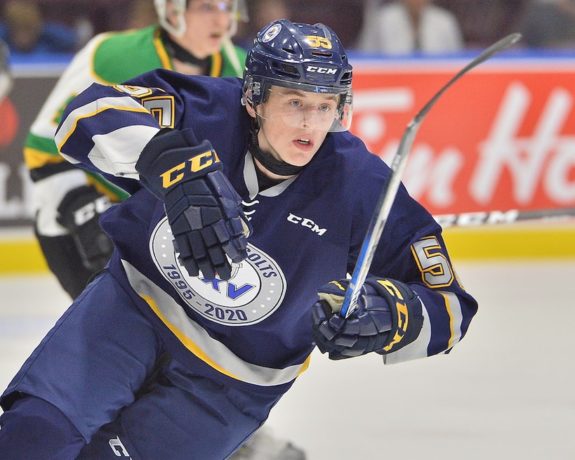
Why he could fall: Clarke tends to play on the line of aggressive and reckless. In the Slovak Extraliga, he currently has 41 penalty minutes, most of which he acquired in a single game. He also laid a dangerous hit to the head on Quinton Byfield early in the 2019-20 season but wasn’t suspended. Generally, he doesn’t play overly physical but can lack discipline, which he will need to learn to control, especially as the league tries to stamp out hits to the head and other dangerous plays. Clarke could just as easily become a Brad Marchand-type on the blue line as he could a Raffi Torres, who still holds the record for the longest NHL suspension with 41 games for a dangerous hit on Jakub Silfverberg.
Carson Lambos
Why he could be first: Carson Lambos has all the makings of a top-pairing two-way defender who’s able to do everything asked of him at a high level. Last season, he led all rookie defensemen in the WHL in scoring with eight goals and 32 points, including 10 power play points in 57 games with the Winnipeg ICE. His performance earned him a spot on Canada White at the U17 World Hockey Championships, where he put up five assists in six games. On the blue line, he uses his 6-foot-1, 201-pound frame to effectively shut down attackers and his fluid skating to close gaps and force them to the outside. While he hasn’t been ranked first yet, he’s the second-favourite choice for Sportsnet’s Sam Cosentino.
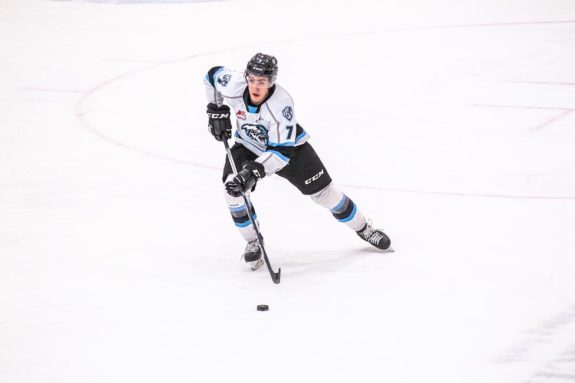
Why he could fall: Lambos’ loan to the Finnish JYP U20 team did not go as smoothly as hoped. He looked outmatched and out of place, although he still managed to score 11 points in 13 games and appeared in two Liiga games. His defensive game looked stronger than it had last season, but there were some significant consistency issues that have many scouts worried. Where he ends up going in the 2021 Draft will largely depend on how he transitions back to the WHL. Scouts love his shot, which can make him a legitimate threat on the power play, and when that dominance returns in the coming weeks, Lambos will be one to watch. Otherwise, the mobile defender could fall out of the top-10 altogether.
Simon Edvinsson
Why he could be first: Simon Edvinsson may be the best two-way defenseman available in the draft, and at 6-foot-5, he’s also one of the biggest. He has incredibly soft hands and can deliver crisp passes right to the tape, creating perfect scoring opportunities. He’s a powerful skater, able to quickly get up to speed and just blaze through the neutral zone. Like Power, once he gets going, he is incredibly difficult to stop. He plays a similar style to Oliver Ekman-Larsson, playing a smart, confident brand of hockey. TSN seems to really like big defensemen, as they put Edvinsson as their second choice after Power.
Why he could fall: A lot of scouts will likely compare Edvinsson to fellow big defenseman Power, and in most regards, he just doesn’t match up. He’s not as offensively gifted, and his weaker shot likely means he’ll never be a 20-goal scorer in the NHL. His defense is good but not great, and despite having a size advantage against most of his competition, he isn’t as physical as most expect him to be. He’s played most of the 2020-21 season in the J20 and Allsvenskan leagues in Sweden, where the competition isn’t as strong as the NCAA right now. In his 10 games in the SHL, he has only recorded a single assist, which is still noteworthy when competing against some of the best Swedish players in the world, but not as impressive as some others on this list.
Kent Johnson
Why he could be first: Kent Johnson has the highest fantasy potential of any other forward in the 2021 class. Last season, he was a standout with the BCHL’s Trail Smoke Eaters, scoring 101 points in just 52 games and earning first All-Star team honors. He was also named the Canadian Junior Hockey League’s Top Forward of the Year. He then joined the University of Michigan, where he’s been just as lethal as a freshman. In his first game in the NCAA, he had four assists in an 8-1 win, then scored a point in his next three games. He currently sits second on the team in scoring with 25 points, just four behind 2020 second-round pick Thomas Bordeleau. He was even nominated for the 2021 Hobey Baker Award, along with teammate Power. Like Lambos and Edvinsson, he hasn’t been ranked first yet, but he was third on Zator’s list.
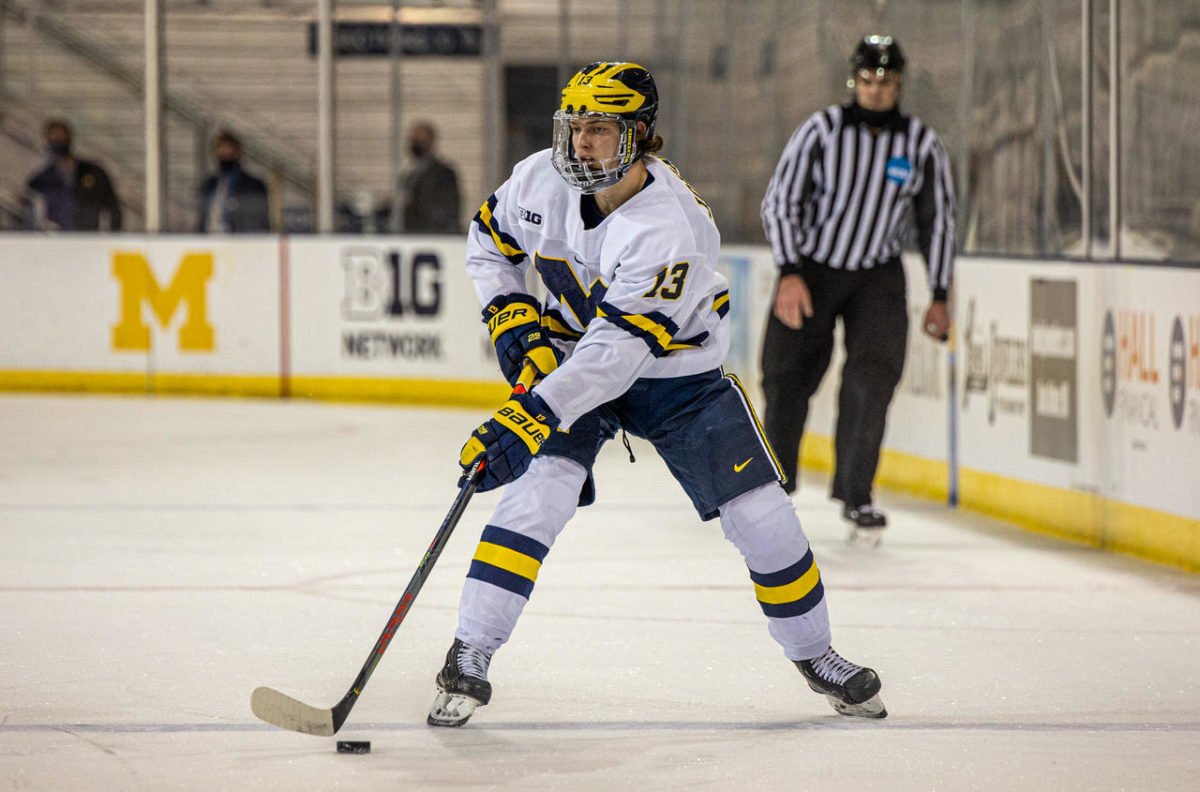
Why he could fall: Johnson carries quite a bit more risk than Beniers or Eklund, largely due to his current size. At just 165 pounds, it would be highly unlikely that he could jump right into the NHL next season. Not all first overall picks make the jump right away — Erik Johnson spent another season at the University of Minnesota after being selected by the St. Louis Blues in 2006. But more often than not, the team that picks first needs the most help and doesn’t want to suffer through another last-place finish. he also picks up quite a few points as secondary assists, which some may see as not as valuable as a player who is recording more primary points.
Aatu Raty
Why he could be first: At one time, Aatu Raty was the favourite for the first overall pick. Now, he’s almost been pushed out of the top-10. What happened? A lot of it has to do with expectations. When Raty came into the 2020-21 season, he was expected to dominate. He had made his U20 debut at 16 years old and was electric, scoring 17 goals and 31 points in 41 games. He made his Liiga debut the following season, where he put up two goals and four points in 12 contests. However, this season, he got off to a slow start, leading to being left off the 2021 Finnish World Junior team despite playing on the 2020 team.
That demotion has lit a fire under Raty. After eight games, he had seven points and was looking much more like the player that caught everyone’s attention back in 2019. He returned to Karpat in January and has been slowly heating back up. In his last seven games, he has three goals and five points. His best attribute is his skating, but there are very few weaknesses in his game, from his shot to his playmaking to his even defensive awareness. There’s a reason he was once a strong candidate for first, and if he continues to find his rhythm, he’ll be back in that conversation soon enough.
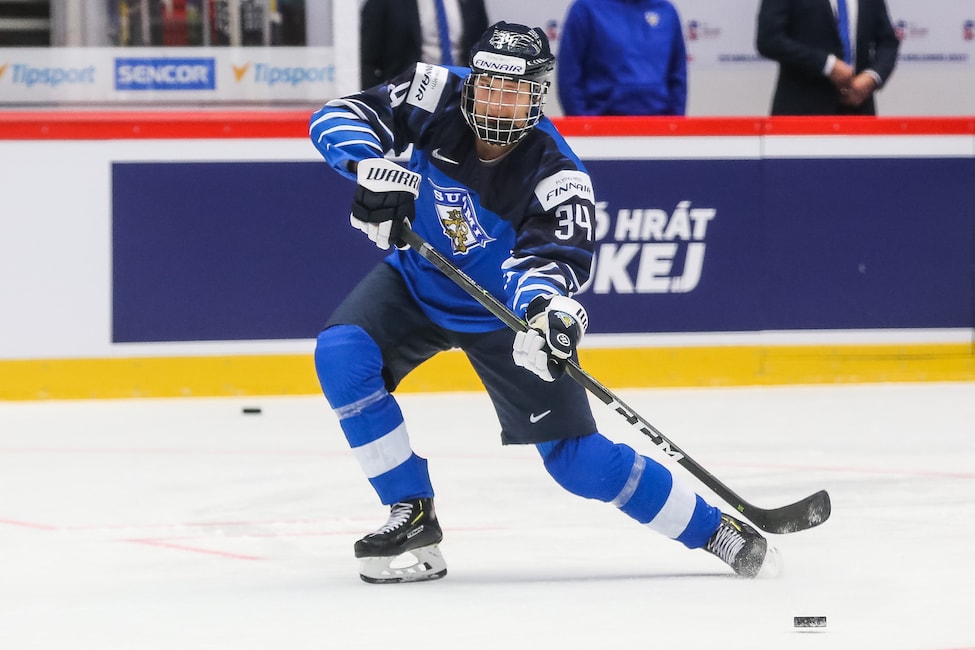
Why he could fall: Not everyone is sold on Raty. He’s been on scouts’ radars for quite some time already, and some are a bit wary of his development, especially the assumption was he’d be a full-time Liiga player this season. Consistency remains a big question for the center, and with him being one of the older players available, some question his NHL potential. While most scouts see his upside as a number two center, some see him as a future third-line center. That’s hardly first-overall pick material.
Bonus – Jesper Wallstedt
Why he could be first: Sweden has produced some of the best goalies in the NHL, headlined by Henrik Lundqvist, but there is talk that Wallstedt could be the greatest goalie ever from the hockey-crazed nation. The 6-foot-3 netminder has been playing in Sweden’s U20 league since 2017-18, when he was just 15 years old, and has excelled at every level of competition, from local to international, rarely posting a save percentage (SV%) lower than .920 in league play. This season, he’s been a starter for Luleå HF in the Swedish Hockey League, where he’s won 12 games in 21 starts and has a .913 SV%. No other under-19 goalie has even played a game in 2020-21. And he’s only going to get better.
Why he could fall: Simply put, he’s a goalie. Drafting goalies has always carried a risk, as they develop at different paces than forwards or defense. But in recent years, teams have been even more hesitant to take a netminder with a high pick. The last goalie to go first overall was Marc-Andre Fleury in 2003, and only three others have gone within the top five since 2000: Rick DiPietro (2000), Kari Lehtonen (2002), and Carey Price (2005). That’s a wide range of talent, despite being such high-profile picks. It’s the reason Yaroslav Askarov, considered the best goalie since Price and virtually a lock for the top 10 in 2020, fell to 11th. As the old adage goes, goalies are voodoo, which means Wallstedt is unlikely to go first overall, despite the obvious talent.
A Draft Like No Other
The 1974 NHL Draft was arguably one of the most chaotic entry drafts of any professional sport. That season, the league welcomed two new franchises in the Washington Capitals and Kansas City Scouts, the third expansion class of the decade, and like those before them, they were given the top picks at the upcoming draft. The Capitals won the right to pick first, but the player they had originally planned on taking, Pat Price, a powerful defenseman with the WHL’s Saskatoon Blades, instead decided to sign with the World Hockey Association’s Vancouver Blazers. So, they went with their second choice, which was another defensemen who was slightly further down most team’s lists, Greg Joly, who became possibly the worst first overall pick of all time.
Things only went downhill from there. The draft could be prolonged for as long as someone wanted to select a player, and the Capitals extended it to an incredible 25 rounds, the longest in NHL history. But unlike today, it didn’t take place in a fancy arena; the draft was held entirely over the phone, in secret, and several days earlier than scheduled in order to prevent further picks being stolen by the WHA. The Buffalo Sabres, frustrated with how things were being handled, decided to have some fun with the format and made up a Japanese player, Taro Tsujimoto, that they then selected in the 11th round.
Could we see a draft that compares to that? So much has changed since the early days of the draft that prevents an event like 1974 from ever happening again, but there already have been several unprecedented events in the months leading up to the 2021 Draft. There are also several prospects who could make late pushes into the top-10 or even top-five. Dylan Guenther is a name to keep an eye on as the WHL season progresses, and if the OHL ever resumes, Mason McTavish is someone who could jump up. In the end, this will be an incredibly exciting time for many young hockey players as they take the next step in their careers and get a little bit closer to realizing their childhood dreams of playing in the NHL.